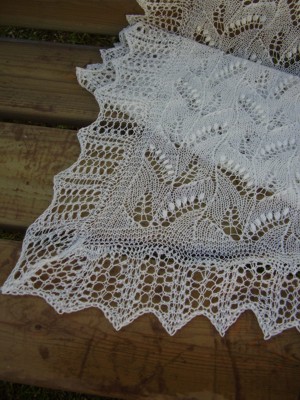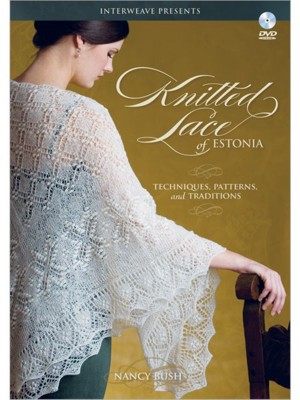 Nancy Bush, an avid American knitter, became an enthusiast of Estonian handicrafts when she found a book at the Salt Lake City Library about 20 years ago. The book was printed in Russian in 1956 and talked about Estonian Folk Costumes. At the end of the book she encountered pictures of beautiful mittens and socks from different Estonian counties. It was love at first sight. .
Nancy Bush, an avid American knitter, became an enthusiast of Estonian handicrafts when she found a book at the Salt Lake City Library about 20 years ago. The book was printed in Russian in 1956 and talked about Estonian Folk Costumes. At the end of the book she encountered pictures of beautiful mittens and socks from different Estonian counties. It was love at first sight. .
Since then she has become further acquainted with the Estonian handicraft culture through other books, magazines and meeting with Estonians abroad and in Estonia. She found the magazine Triinu, which was published by Estonians abroad, a treasure chest. Nancy Bush has become a devoted promulgator of Estonian handicrafts through her famous knitting seminars, the prestigious handicraft magazine Piece Work and her books written about Estonian knitting traditions. Piece Work magazine has published her stories, pictures and patterns of the Estonian knitting culture, the stories of World War II Estonian refugees’ handicraft work and the Haapsalu lace shawl.
In her quest to become better acquainted with Estonian knitting traditions, Nancy visited Estonia, “met the Haapsalu shawl” on her first trip and adopted it immediately. “Awesome, they also knit lace here”, she thought and immediately purchased one as a gift for her mother. It took planning, research and recurrent trips to Estonia to finalize the “adoption papers”; that is she became an expert in the knitting techniques of the shawl. The 2012 the Novem-ber/December issue of the the Piece Work carried the story of the lace shawl which has close to a 200-year history, including instructions and some patterns. Nancy has also written a book about the Haapsalu’s lace shawl and is dreaming about a Haapsalu Lace Shawl museum in Estonia.
In college Nancy studied art history, but never became very interested in the fine arts. For her, the folk art cultures of different peoples has always been the most captivating. In Estonia, she likes almost everything; the songs, dances, food and of course Haapsalu. She is not quite as fascinated by composer Arvo Pärt and a bit reserved when it comes to studying the language at this juncture of her life.
Through her mail-order shop Woolywest.com one is able to get quality wool yarns and colors, unique patterns collected and/or created by her, accessories and useful knitting tools together with expert instructions to the customers, including her books. One can also obtain books through her store about Estonian knitting and needlework written by Anu Kabur, Anu Pink, Mai Mereste, Siiri Reiman and Aime Edasi.
Beside writing for Piece Works, Nancy has also written books about knitting techniques and designs from Northern Europe and the British Islands – “Folk Socks” – (a new edition of the book originally published in 1994 is now available). In her book: “Folk Knitting in Estonia” she has written all about the Estonian knitting traditions and patterns for mittens and socks as well as information on their history in Estonia. Her latest book: ”Knitted Lace of Estonia – Techniques, Patterns and Traditions” also carries an instructional DVD that includes a chapter on the history of the beautiful Haapsalu knitted shawls and scarves. Add to this her seminars and one can see how Nancy Bush is carrying the unique tradition of Estonian lace knitting all over the USA, as well as to many other countries. Just this past July Nancy held knitting seminars and lectures in Sweden. A lot of time and money has been spent on travel and Nancy does feel that her present lifestyle keeps her away from her home and her beloved husband. Luckily her husband is very supportive, knowing that Nancy is doing what she loves and cherishes.
Asked why a person should knit at all nowadays, or make other handcrafted articles, when it may be so much easier to simply purchase all kinds of socks, shawls and other ready-made items similar to handicrafts, she responds: “therapy.” …and tradition. Yes, Nancy Bush, the “adoptive parent” of the Haapsalu lace shawl, sees knitting as therapy. It is something that helps the thoughts to settle, the mind to find solutions to problems, and most importantly it gives a person satisfaction in being able to create something. Beside, people sitting behind the technical machines lose contact with the real world. Knitting helps to establish balance. It is good for mental and spiritual tranquility (and has even been recommended by some doctors).
This past spring Nancy took a group of her more devoted knitters on a tour through Estonia. She held some seminars and conferences in Tartu and Tallinn; visited museums, Pärnu, and of course ended up in Haapsalu. Her trip coincided with mine and I was to meet her in Tartu. Unfortu-nately plans were thwarted due to some health problems. But I did, however, meet her for a very brief hello and embrace in Tallinn and was completely taken in by her outgoing personality. Hopefully I will be able to see her in the future somewhere closer to home.
Nancy Bush is completely American in her speech and conduct, more enthusiastic and outgoing than the everyday Estonian. Regardless of her plaited, “salt and pepper” hair and glasses, her eyes sparkle, especially when she speaks about her favorite Haapsalu shawl or her beloved husband or when meeting someone who shares her enthusiasm for folk art. Nancy Bush’s roots reach back to Sweden and sometimes she muses that perhaps a flaxen-haired Estonian maiden was represented in her Viking fathers’ history. Yet, Nancy never defines herself through any nationality. “It had to be fate!” she says. How else could one explain that how an American who has lived her entire life in Salt Lake City, in the State of Utah (perhaps with a bit more interest in knitting than common), became an enthusiast in the knitting culture of Estonia, a country so little known by the public at large.  Among other things she has discovered; interesting techniques of Estonian cast-on and texture stitching and special ways of finishing to give unique effects to the knitting.
Among other things she has discovered; interesting techniques of Estonian cast-on and texture stitching and special ways of finishing to give unique effects to the knitting.
Nancy feels that the Haapsalu lace shawl has presently been entrusted to her care and would very much like to see a museum created to honor this valuable inheritance. However, she also feels that even if she had the means, it would really not be up to her. The establishing of the Museum should come via the Estonians themselves. To her it seems that the Estonians are not valuing their precious ancestral inheritance enough. Also, in her eyes the city of Haapsalu is not seeing the real importance of this type of museum, both for its historic value and also as a tourist attraction. What of all the spa visitors who might even be introduced to knitting therapy through some summer seminars held at the Museum?! She feels that presently the city of Haapsalu and the Estonian people are on the verge of losing a piece of Haapsalu’s history and the Estonian knitting tradition.
It only remains to be asked: why do we Estonians squirrel away our cultural heritage like some forgotten item in an old strongbox in the attic – something unworthy to be displayed and treasured? Sometimes it seems that we value something in our culture only if it carries the imprint of some previous occupier. This seems to apply to our history as well. We prefer to quote our ancient and recent history as written by our previous colonizers and occupiers instead of expressing the truth of our historical struggles. Often we give voice to our subjugators as they boast of having brought us cultural enrichments, never mentioning how they, first, annihilated much of our ancient values and customs and later inserted their own values and mannerisms while claiming our culture’s innovations and creations as their own. Only a couple of years ago I met an American girl who was wearing one of our beautiful folk costume belts on her jeans. Since it was one of the belts I had also woven, I inquired of its origin and she informed me that it was Russian and she had purchased it in Moscow.
Coming back to our handicraft traditions, Nancy Bush has presently done more than any Estonian currently for the revitalization of our knitting traditions, especially the shawl. She has not only gathered the designs for the shawl, but is also spreading its beauty and the particular Estonian knitting techniques employed in its creation all over the world, along with the name of Estonia. She has mentioned that her relationship with Estonia feels like a gift to her from above.
Thus, to further avert the eradication of our foremothers’ handicrafts and folk art, we should all recognize the value of our Haapsalu Shawl through the eyes of Nancy Bush and not only help her to dream of a Museum, but to realize this asset for our own history and cultural enrichment. It is up to us. It would be an appropriate way to thank Nancy Bush for seeing the value of and publicizing our folk art and to thank our forbears for the abundant cultural and historical heritage which they created and have bestowed upon us.
In fact, it looks as if Nancy is the gift to Estonians.
On the photo: DVD Knit an Estonian Lace Shawl from Beginning to End with Expert Nancy Bush.
Aime Andra
















